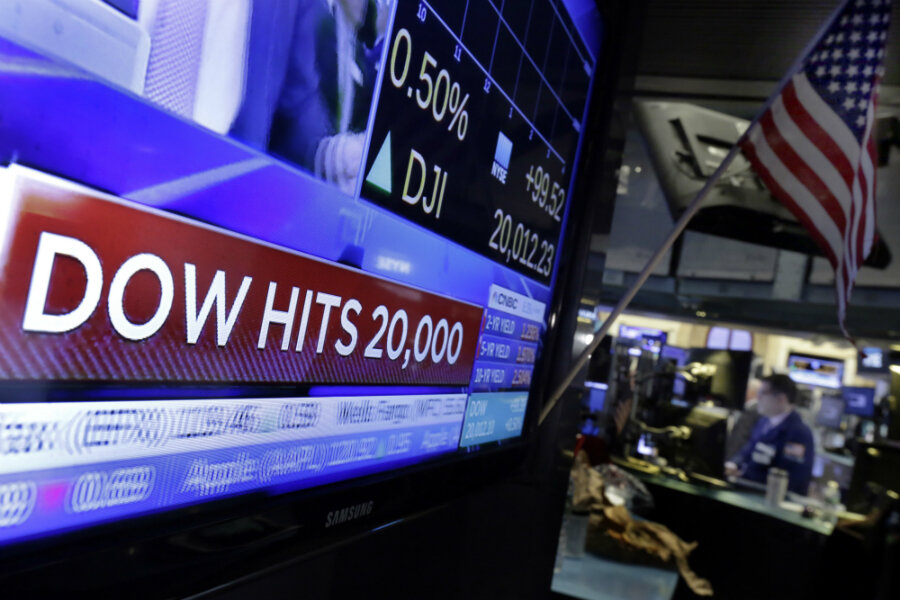Dow hits 20,000 for the first time. Does it really matter?
Loading...
For the first time in its 120-year history, the Dow Jones Industrial Average traded above 20,000 on Wednesday, prompting celebrations as the market resumed a rally that began shortly after President Trump won the election last fall.
Driven upward largely by stocks in the financial sector, the rapid ascent continued after Mr. Trump signed a number of executive orders Tuesday, including a push to allow for the construction of two controversial oil pipelines – news that could be a boon to the energy industry. Some hailed the milestone as evidence that Trump, as a billionaire businessman himself, will usher in a pro-business administration with a major boost to the American economy, while others described the news as an inevitable development in an economy that has been on the upswing for months.
"Trump's been on the job for five days and he's a man of action," Brian Battle, the director of trading at Performance Trust Capital Partners in Chicago, told Reuters. "That should get everyone confident he'll get those three other things done ... which is taxes, trade and regulation."
When nearly 63 million Americans voted last November for Trump, they sent a clear message that they want radical change – including less regulation of certain industries and tax cuts for corporations and individuals, which could drive short-term economic growth, as The Christian Science Monitor reported.
The word "growth," in fact, is perhaps the single term that best sums up Trump's perspective on a healthy US economy. While 2.1 percent annual growth has been average since 2009, Trump has said the economy can grow much faster, by as much as 4 percent annually, an ambitious goal. While widespread tax cuts and reductions in regulation, plus infrastructure spending, would likely "add more juice to the economy," the changes are unlikely to take effect before 2018 and 2019 – and critics say the ultimate impact of Reagan-style rollbacks could worsen inequality.
Furthermore, the market's upward march has been steady since it bottomed out in spring 2009, following the financial crisis. Some observers see the 20,000-point threshold as merely inevitable.
"Even though it took a little while, after several close calls in recent weeks, it’s hardly a surprise that the Dow hit this particular milestone," Jay Zagorsky, an economist and research scientist at The Ohio State University, wrote in a commentary piece for The Conversation. "It and other major stock indexes like the Standard & Poor's 500 have two key features that ensure that they will continually rise and break new zero-filled records: They ignore inflation and are heavily curated."
Since the beginning of this century, inflation in the United States has held relatively steady, at around 2.2 percent annually, Dr. Zagorsky wrote. At that rate, prices for most things, including stocks, double about every 32 years – meaning the Dow Jones Industrial Average will, if the rate holds, hit 40,000 in about three decades.
For decades, the average has been comprised of a basket of 30 curated stocks, but there have been 133 different companies on the list since it was created more than 120 years ago, because the editors of The Wall Street Journal choose each year which companies to keep or remove from the list.
"Replacing under performing companies that have a falling stock price, with companies that have a rising stock price ensures the index continues to climb over the long term," Zagorsky added.
Even so, the post-election rally has set an impressive record not only for its historic highs but also for the impressive pace at which it has attained them. The index surpassed 19,000 for the first time on Nov. 22, 2016. If it remains above 20,000 by closing time Wednesday, its surge would be the second-shortest span between two such milestones: just 42 trading sessions.
The most rapid rise took 24 days to go from 10,000 to 11,000, and the rise from 18,000 to 19,000 took 483 sessions.
This report includes material from Reuters and the Associated Press.






